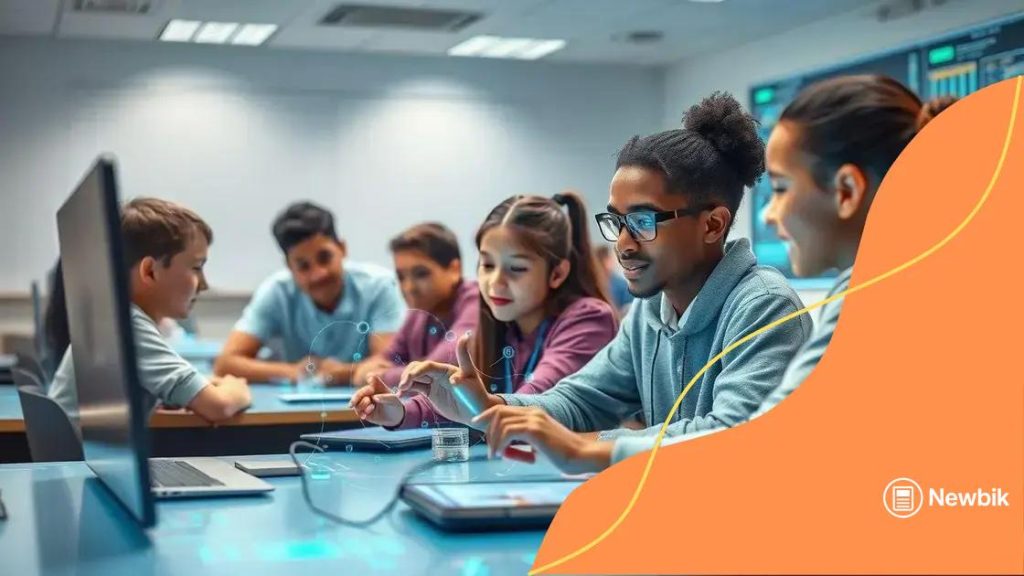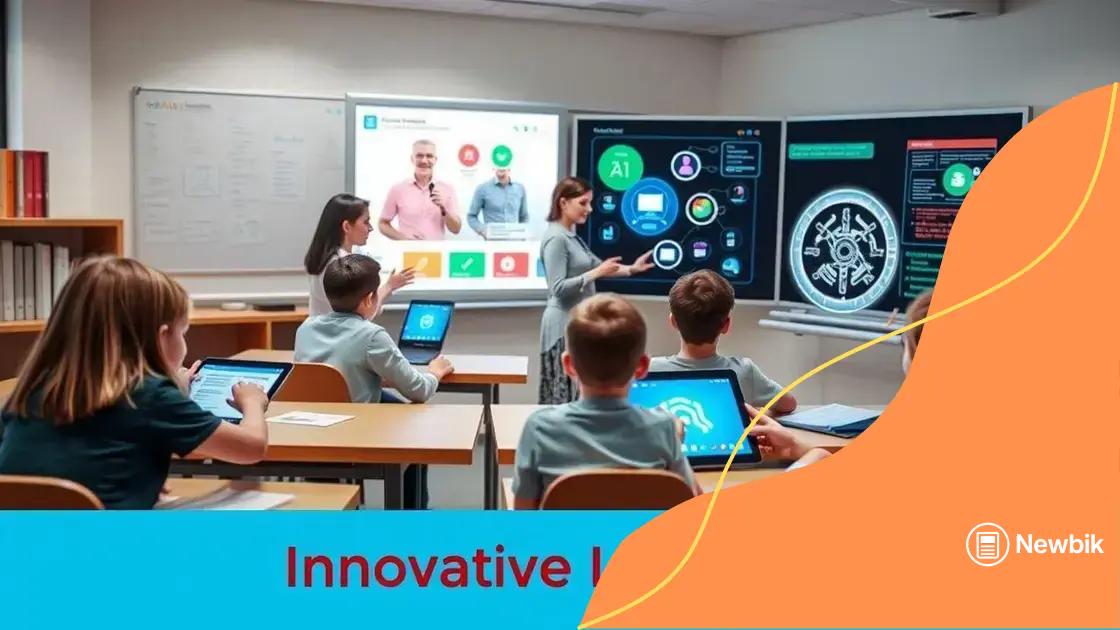The integration of artificial intelligence into educational settings

The integration of artificial intelligence into educational settings enhances personalized learning, improves teaching efficiency, and offers valuable insights while addressing challenges such as data privacy and accessibility.
The integration of artificial intelligence into educational settings is transforming the learning landscape. Have you ever wondered how technology can make learning more effective and engaging? In this article, we’ll explore the impacts of AI on education, from personalized learning paths to administrative efficiencies.
Understanding artificial intelligence in education
Understanding artificial intelligence in education is crucial for teachers and students alike. By leveraging AI technologies, educational institutions can enhance learning experiences in numerous ways. AI can offer personalized learning by adapting to each student’s unique needs.
What is Artificial Intelligence?
Artificial Intelligence (AI) refers to computer systems that mimic human intelligence. These systems can process information, learn from data, and make decisions based on inputs.
In education, AI can help in creating customized educational content. This technology can analyze students’ strengths and weaknesses, allowing for tailored lessons.
Applications of AI in Education
- Personalized Learning: AI can track student progress and provide tailored recommendations.
- Administrative Tasks: AI can automate grading, helping teachers save time.
- Intelligent Tutoring Systems: These systems offer students personalized feedback and guidance.
Using AI not only helps in improving student performance but also frees up valuable time for educators to focus on teaching strategies. The goal is to create a more effective learning environment that can adapt to ever-changing student needs.
Challenges of Implementing AI
While AI offers many benefits, there are challenges in its integration. Issues such as data privacy, access to technology, and the need for teacher training must be addressed. Ensuring that all students have equal access to AI tools is vital for successful implementation.
As the educational landscape continues to evolve, understanding how to effectively incorporate AI is essential. Educators and institutions must collaborate to make the most of these advanced technologies, ensuring a brighter future for all learners.
Benefits of AI for students and teachers
Benefits of AI for students and teachers are numerous, making it a valuable tool in modern education. Both students and teachers can significantly gain from integrating AI into the classroom. This technology enhances learning experiences and streamlines teaching processes.
Enhancing Personalized Learning
AI can analyze student performance and adapt lessons accordingly. This means that students receive content tailored to their learning pace and style. For example, if a student struggles with a subject, AI can provide additional resources to help them understand better.
- Tailored Learning Paths: Customized strategies to meet individual needs.
- Immediate Feedback: Instant responses to student tasks, helping them improve.
- Engaging Content: AI can create interactive lessons that captivate students’ attention.
In addition to benefits for students, teachers also experience positive outcomes. AI can help teachers identify which students need extra assistance and what teaching methods are most effective.
Efficiency in Administrative Tasks
Managing a classroom can be time-consuming. AI helps alleviate this by automating routine tasks such as grading and attendance tracking. With AI handling these administrative duties, teachers can focus more on instruction and less on paperwork.
Furthermore, AI tools assist in developing curriculum materials and resources quickly. This efficiency allows teachers to dedicate more time to interact with their students and improve their teaching methods. By using AI, the workload for educators becomes more manageable, making it easier to foster an engaging classroom environment.
Ultimately, the integration of AI in education supports a more dynamic, personalized, and efficient learning experience. By leveraging these technologies, both students and teachers can reach their full potential.
Examples of AI tools in educational settings

There are many AI tools in educational settings that can enhance learning, making it more interactive and personalized. These tools are used in classrooms around the world to support both students and teachers in their daily activities.
Popular AI Tools for Education
Several notable AI tools are transforming education. Each tool serves a specific purpose to help improve outcomes for students. For instance, AI tutoring systems adapt to individual student needs, offering tailored support.
- Knewton: This adaptive learning platform personalizes content for each student, ensuring they learn at their own pace.
- Duolingo: Using AI algorithms, this app customizes language learning experiences and tracks user progress effectively.
- Edmodo: This communication platform utilizes AI to facilitate interactions between teachers, students, and parents while keeping everyone engaged.
- Socrative: An assessment tool that analyzes student responses in real time, helping teachers adjust their lessons accordingly.
These AI tools not only improve learning experiences but also facilitate administrative processes. For example, AI-based grading systems can handle evaluations faster, allowing teachers to focus on teaching rather than paperwork. Additionally, platforms like Google Classroom provide an organized space for assignment management, promoting collaboration among students.
The Impact of AI Tools
The use of AI tools encourages active participation and engagement among students. They help create a more dynamic learning environment. By using engaging methods, AI tools keep students interested in their studies.
As technology continues to evolve, education is being transformed by these tools. Schools are adopting various AI solutions to enhance not only student learning but also to support teachers in their responsibilities. This change creates opportunities for innovative teaching practices that benefit everyone involved.
Challenges faced with AI integration
Integrating AI into educational settings comes with several challenges that schools must address. These obstacles can impact the effectiveness of AI adoption and its overall success in enhancing learning experiences.
Data Privacy Concerns
One of the biggest issues is ensuring data privacy for students. Schools collect personal information to tailor educational experiences, but this data must be protected. Implementing strict guidelines and security measures is essential to maintain trust.
- Compliance with Regulations: Institutions must comply with laws like FERPA and COPPA that protect student data.
- Data Breaches: Schools need to be prepared for potential security breaches that could expose sensitive information.
- Parental Consent: Obtaining consent from parents or guardians for data collection is necessary to ensure transparency.
Another significant challenge is the accessibility of technology. Not all students have equal access to devices or the internet, which can create disparities in learning opportunities. Ensuring that all students can fully participate in AI-enhanced learning is crucial.
Teacher Training and Support
Teachers must also be adequately trained to use AI tools effectively. This involves providing professional development that focuses on how to integrate these technologies into the curriculum. Without proper training, teachers may struggle to utilize AI’s full potential.
Additionally, schools often face issues related to funding and resources. Implementing AI solutions can be costly, and many institutions must grapple with budget constraints. Finding ways to fund technology initiatives is essential for successful integration.
Ultimately, addressing these challenges is vital for schools that wish to harness the benefits of AI. By tackling issues related to data privacy, accessibility, training, and funding, educational institutions can better prepare for the future of learning.
Future trends in AI for education
Future trends in AI for education are exciting, as technology continues to evolve and influence teaching and learning practices. The integration of AI in educational settings is expected to grow, leading to innovative approaches that enhance the educational experience.
Personalized Learning Experiences
One major trend is the shift towards more personalized learning experiences. AI can analyze individual student data to provide tailored recommendations. This ensures that each learner gets the support they need at the right time.
- Adaptive Learning Systems: These systems will become more refined, using AI to adjust the difficulty of tasks based on real-time assessments of student performance.
- Learning Analytics: Data-driven insights will help educators understand how students learn best, allowing for even more customization of instruction.
- Virtual Reality (VR) and Augmented Reality (AR): Combining AI with VR and AR can create interactive, immersive learning environments that enhance student engagement.
As AI technology progresses, more sophisticated tools will emerge. Such tools can offer predictive analytics, helping educators anticipate student struggles before they arise.
Enhanced Teacher Support
Another trend focuses on improving support for teachers. AI can assist in managing administrative tasks, thus giving educators more time to focus on teaching. For example, AI-driven platforms can help with grading and provide insights into student behaviors and learning patterns.
Moreover, AI can facilitate professional development for teachers. Personalized training programs based on individual teacher needs can improve their effectiveness in the classroom. Schools might use AI tools to identify areas where teachers need support and provide targeted training.
Ultimately, as AI becomes more integrated into education, it will reshape how students learn and how teachers teach. Embracing these future trends can lead to a more effective, engaging, and inclusive educational environment.
In conclusion, the integration of AI in education is transforming how students learn and how teachers teach. By personalizing learning experiences and enhancing teaching methods, AI tools create dynamic and effective educational environments. Despite challenges such as data privacy and accessibility, the benefits of AI far outweigh the obstacles. Looking ahead, AI’s role will only continue to grow, making education more engaging and tailored for every learner. Embracing these innovations is essential for shaping a brighter future for education.
FAQ – Frequently Asked Questions about AI in Education
How does AI personalize learning experiences for students?
AI analyzes individual student performance to tailor lessons and resources, ensuring that each student receives support that fits their unique learning style.
What are some examples of AI tools used in classrooms?
Examples include Knewton for adaptive learning, Duolingo for language practice, and Socrative for real-time assessments.
What challenges do schools face when integrating AI?
Challenges include ensuring data privacy, providing equal access to technology, and training educators to use the tools effectively.
What future trends can we expect with AI in education?
Future trends include more personalized learning, enhanced teacher support, and the use of data-driven insights for improving curriculum design.